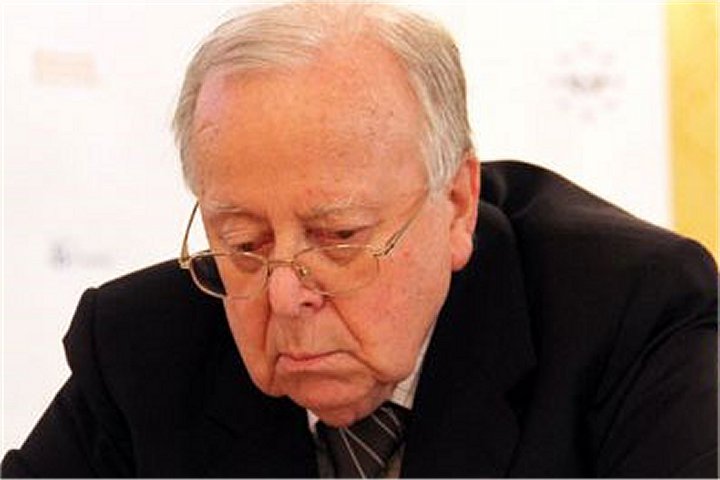Uhlmann’s defense - a new concept against the King's Indian Attack
Recently, when wondering how to counter the Grand Prix Attack in the Sicilian Defense, I came across a nice and helpful concept. In the Grand Prix Black often has to deal with a white queen on h4 that took its standard route d1-e1-h4 to set itself up to play a major role in White’s attack against the black king. Now I know how to neutralize this queen.
I remembered a similar motif from the King’s Indian Attack (KIA) that I learned back in the day as a kid when the Berlin Wall still stood and the German Democratic Republic still existed – Grandmaster Wolfgang Uhlmann being its best player.
Knowing Uhlmann’s defense …Qe8 has helped me again and again to stay calm and to be ready for effective countermeasures when my opponent prepared an attack against my king. The attacker should also know this defensive idea to avoid running into a counterstrike that stops the attack before it really began. The idea does not only occur in the KIA, but that’s where it is employed most often.
Its history, however, began with a crushing defeat. At the tournament in Moscow 1971 Uhlmann first tried the idea against the great David Bronstein and was fine after …Qe8 but only one move later he blundered the game away (see below).
Against 1.e4 Uhlmann always played the French and in the early 1970s he often had to face 1.e4 e6 2.d3 followed by a KIA setup because Bobby Fischer loved the KIA (Fischer’s legendary book My 60 memorable games begins with a KIA game), and other grandmasters tried to walk in Fischer’s footsteps, and fighting the French with a KIA setup became a common method on the highest level.
When Fischer introduced the idea 13.a3! to win a fine game against Myagmasuren at the Interzonal Tournament 1967 in Sousse a fierce theoretical debate followed:
No other World Champion was more infamous both inside and outside the chess world than Bobby Fischer. On this DVD, a team of experts shows you the winning techniques and strategies employed by the 11th World Champion.
Grandmaster Dorian Rogozenco delves into Fischer’s openings, and retraces the development of his repertoire. What variations did Fischer play, and what sources did he use to arm himself against the best Soviet players? Mihail Marin explains Fischer’s particular style and his special strategic talent in annotated games against Spassky, Taimanov and other greats. Karsten Müller is not just a leading international endgame expert, but also a true Fischer connoisseur.
Usually, we avoid pawn moves on the side where the opponent attacks because such pawn moves might create targets for the opponents. But Fischer’s idea is an exception to the rule. By playing a3 White prevents Black from playing …a3, which would weaken the black squares in White’s camp that a black knight (going from c6 to a7 to b5, the typical route) would love to exploit. After …bxa3 bxa3 the black squares would also be weak but White retains more flexibility in his queenside structure. Should Black play …Nd4 (another typical move) White can kick the horse with c2-c3.

W. Uhlmann - B. Fischer, Chess Olympiad Leipzig 1960 | Photo: Tournament book
World Championship Candidate Wolfgang Uhlmann had to come up with countermeasures. He did but stayed true to Black’s classical and most principled setup which involved a pawn storm on the queenside while facing an attack on the kingside – and he was right. 50 years later it turned out that Black is doing well in this line – despite Fischer’s move 13.a3.
Uhlmann’s defense is a method to defuse White’s attacking move Qh5. So, let’s take another look at Bronstein-Uhlmann.
Should White now play 14.Qh5 he has to have an eye on Black’s option …f5. This move attacks the white queen and White wouldn’t have the time to take on f6 en passant. And once Black installed a pawn on f5 he controls the g4 square and his king’s position becomes unshakable.
Obviously, after 14.Qh5 the immediate 14…f5 is not possible: 15.Qxh7# would be a problem. Therefore, Black takes on g5 first, and now another idea of Uhlmann’s defense becomes apparent: After 14.Qh5 Bxg5 White would love to play 15.hxg5 with a typical grip on the f6 square, followed by Nf1-h2-g4-f6+ and checkmate. But 15.hxg5 would now be answered by 15…f5!. Therefore, White has to play 15.Qxg5, after which his pieces are no longer ideally placed for a kingside attack.
Bronstein (being a former World Championship Candidate himself) understood what Uhlmann had in store for him. He avoided it by playing 14.Qg4 – threatening 15.Nxe6 – instead of 14.Qh5. Maybe Uhlmann was still excited about getting to play his idea against one of the game’s greatest? At any rate, he immediately blundered the game away and played 14…a4??. After 15.Nxe6 he resigned.
One year later in Amsterdam Uhlmann faced US Grandmaster Walter Browne with the black pieces, and the position after 13…Qe8 quickly appeared on the board again. Uhlmann had faith in his setup, and Browne feared an improvement should he follow Bronstein’s 14.Qg4.
Browne went for Uhlmann’s king with the principled 14.Qh5 Bxg5 15.Qxg5. Three moves later the white queen reappeared on h5 and Uhlmann could finally reveal the point of his concept with …f5:
Black is doing well and went on to win convincingly.
Wolfgang Uhlmann (83) ist still around today, and he still plays chess occasionally. In April 2016, two weeks after his 81st birthday, he was called once again to compete for the team of his hometown Dresden in the Bundesliga, the incredibly strong German 1st division. To play there as an 81-year old is a record that won’t be broken anytime soon.
Up to this day Uhlmann trusts his beloved French defense (and the King’s Indian) with Black, and he still implements his ideas from when he was among the world’s best. Have a look at what happened in 2006 when he faced FM Michael Becker with the black pieces in a team match in Germany’s 3rd division:
And now guess who won that game!

Fortunately, Uhlmann has spread his chess wisdom. The most notable among his writings is his 2012 book on the French defense ("A lifetime of playing the French") which, however, is only available in German. If you do understand some German we heartily recommend his ChessBase DVD "My best games", a collection of insightfully annotated classics that see Uhlmann battling against the world’s best.
To finish, let’s look at a related idea in the Grand Prix Attack.
This is just a typical position to illustrate the concept. The key move …e6 prepares …h5! and …Ng4!, either forcing the white queen to go back to its camp or to force an exchange of queens after which Black can proceed to bulldoze the queenside without having to fear for his king.
This motif appears quite often in structures like these. In fact, the whole play of Black is often based on it, and I felt a little bit ashamed that this was news to me.
But make sure to remember it when they come for your king!

























